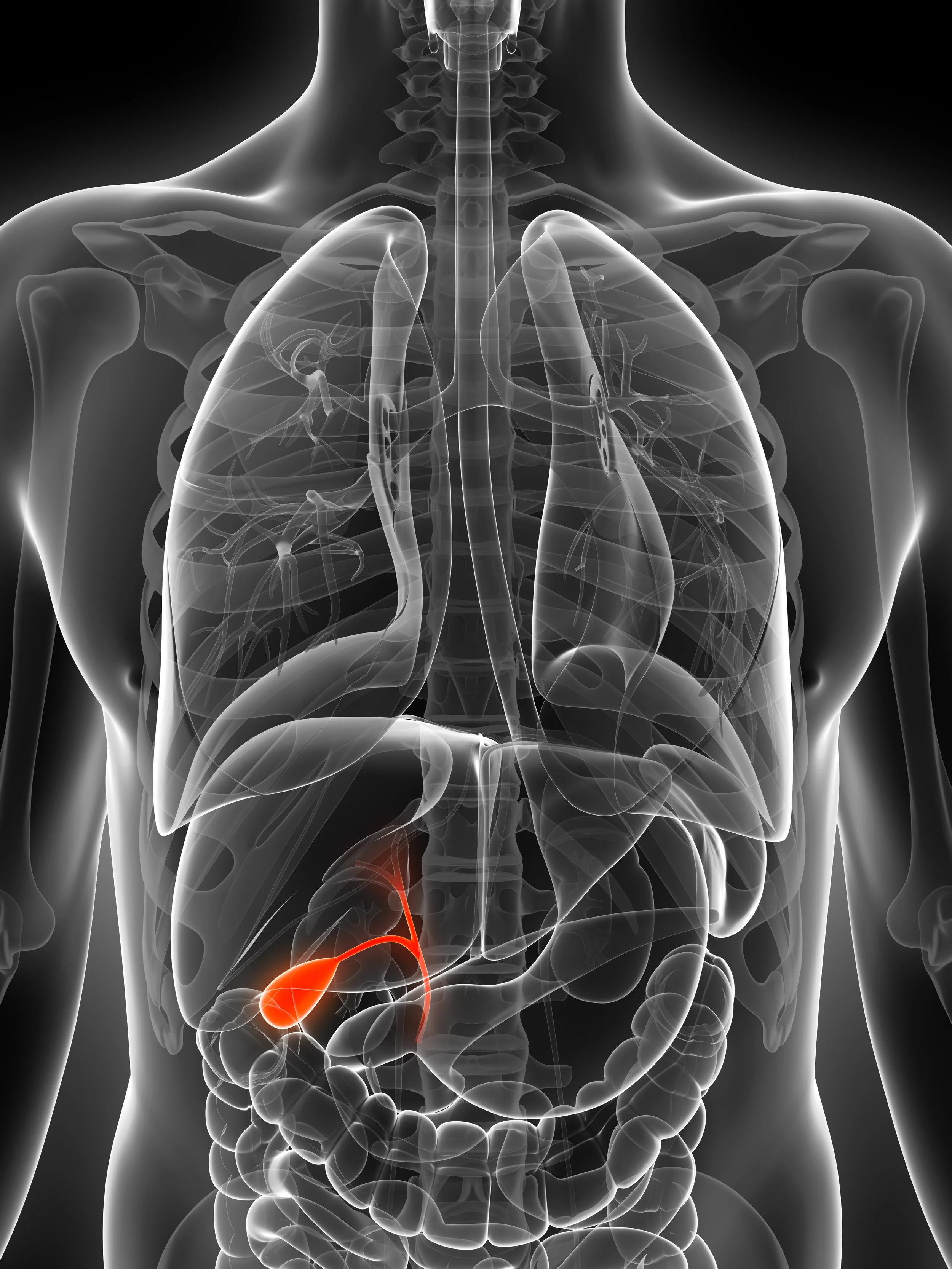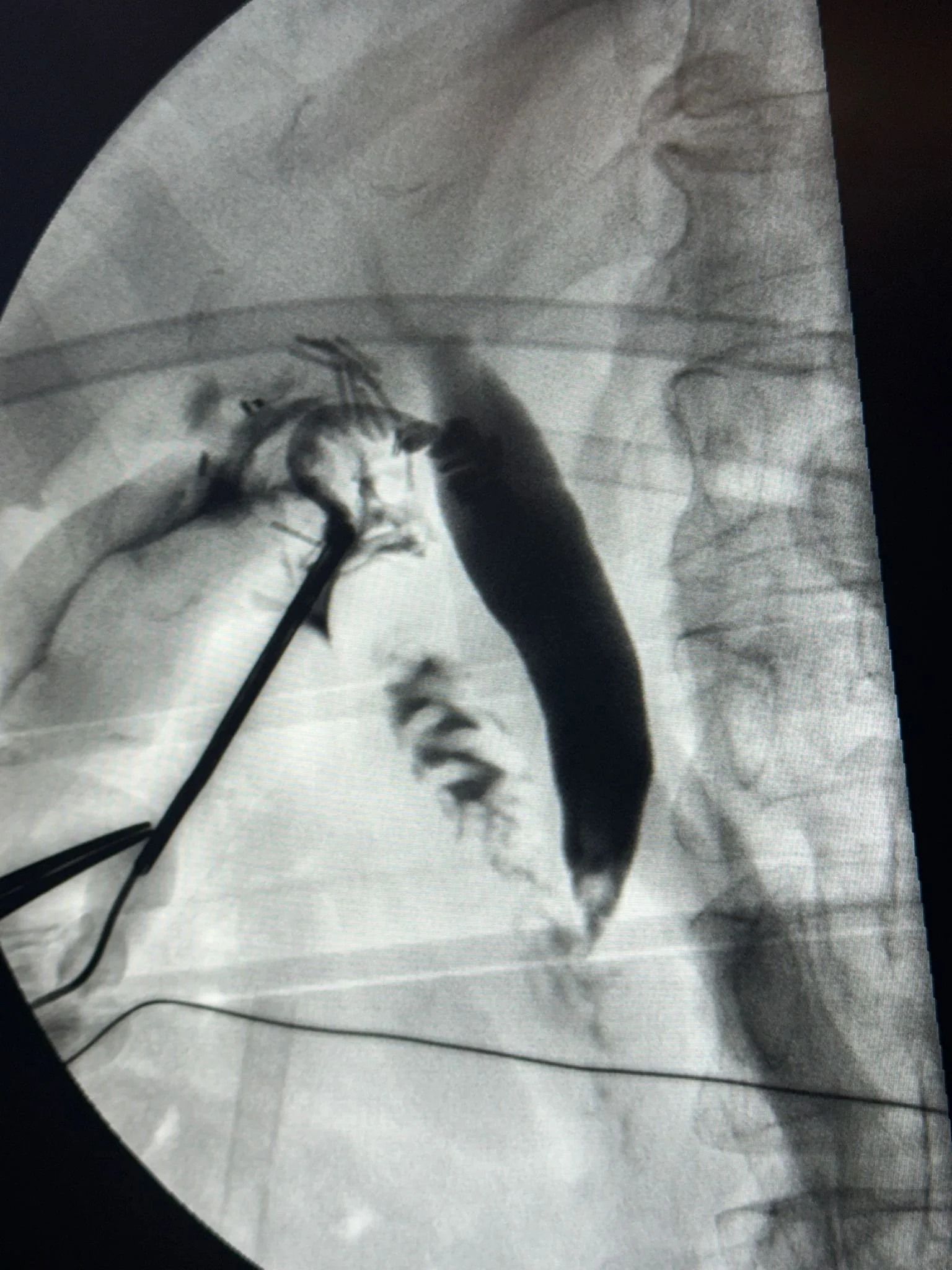
Frequently asked questions about gallstones
Where is my gallbladder and what does it do?
The gallbladder is a small pear-shaped organ that can be found under the liver on the upper right-hand side of the abdomen. The main function of the gallbladder is to store, concentrate and release bile into the small intestine to help digest fats in our diet. The gallbladder can store about 60ml of bile. When you eat food which contains fat, it stimulates the secretion of a hormone called cholecystokinin (or CCK) which causes your gallbladder to rhythmically contract to release bile down the common bile duct (CBD) and into your intestine to mix with food.
What is bile?
Bile is a yellow-green fluid produced by the liver. Our livers produce approximately 500-800ml of bile per day. Bile is composed mostly of water (98%) as well as bile salts, bile pigments (such as bilirubin), fats (such as cholesterol) and inorganic salts. Mixing of the two main bile pigments (bilirubin which is orange and biliverdin which is green) is what gives our stools their brown colour!
What are gallstones and why do they form?
Gallstones form when the substances in bile - primarily cholesterol, bile salts and bile pigments (such as bilirubin) - become imbalanced and precipitate into solid crystals. These crystals can grow into stones over time. The key mechanisms behind gallstone formation are [1] cholesterol supersaturation - this is when too much cholesterol is secreted into bile which can form cholesterol stones, [2] impaired gallbladder motility - this is when the gallbladder does not empty completely or frequently enough (e.g., due to fasting, pregnancy, or certain medications), [3] conditions that cause increased bilirubin such as certain forms of anaemia, liver disease and infections which can lead to pigment stones (usually smaller and darker than cholesterol stones), and [4] inflammation or infection which can cause chemical changes in bile, promoting stone formation.
What are the symptoms of gallstones?
Most people with gallstones do not have any symptoms and are therefore asymptomatic. However, when gallstones block the flow of bile they can cause a range of symptoms including sudden, intense pain in the right upper abdomen which often occurs after a fatty meal. This is called biliary colic. The pain may radiate to the right shoulder or back and typically lasts anywhere from 30 minutes to a few hours. The pain usually settles on its own. Nausea and vomiting is common with biliary colic episodes. Other associated symptoms of gallstones include indigestion and bloating. Gallstones can cause inflammation/infection of the gallbladder which is known as acute cholecystitis (see next FAQ).
What is acute cholecystitis?
Acute cholecystitis is acute inflammation/infection of the gallbladder and presents with severe pain in the right upper abdomen often associated with fever and vomiting. The pain usually lasts for several hours and is severe enough for most people to attend the Emergency Department in hospital. Initial treatment consists of antibiotics and a drip to keep patients hydrated. Surgery can be performed to remove the inflamed gallbladder in this acute setting or may be done at a later stage once the inflammation has settled (around 6 weeks later).
Can gallstones cause other complications?
Gallstones can migrate from the gallbladder into the common bile duct (CBD). Doctors often refer to these as CBD stones or choledocholithiasis. Some CBD stones may pass on their own from the bile duct to the intestine, but often these stones will cause further complications such as jaundice, sepsis or pancreatitis. Jaundice is when your skin and eyes turn yellow due to a build-up of bilirubin in the blood and results from a blockage or obstruction to the flow of bile down the bile duct into the intestine. Sometimes this obstruction can cause an infection within the bile ducts resulting in severe sepsis (also known as cholangitis). Stones which block the duct from the pancreas gland (see image) at the lower end of the bile duct can cause pancreatitis which is a serious condition requiring in-hospital treatment.
How are gallstones and bile duct stones diagnosed?
If you have symptoms consistent with gallstones, an ultrasound (US) scan will diagnose stones in the vast majority of cases. The ultrasound scan will also measure the diameter of your common bile duct. If the bile duct is bigger than normal, it might be an indicator of common bile duct (CBD) stones. Liver function blood tests measure the concentration of bilirubin in your blood as well as measure the liver enzymes. Raised liver function blood tests may also be an indicator of CBD stones. CBD stones can be diagnosed pre-operatively with a special MRI scan (called MRCP) or intra-operatively with a cholangiogram. This image is an example of an intra-operative cholangiogram which in this patient demonstrates a grossly dilated bile duct and CBD stone. At Gallstone Surgery London, we are experts in the management of gallstones and CBD stones. In this patient, the CBD stone was successfully removed from the bile duct at the time of gallbladder removal and the patient was able to go home the same day.
How are gallstones treated?
The primary treatment for gallstones is keyhole (laparoscopic) surgery to remove the gallbladder. This is known as laparoscopic cholecystectomy. Surgery is indicated for patients with symptomatic gallstones or those who have developed other complications of gallstones such as acute cholecystitis, jaundice, cholangitis, sepsis or pancreatitis. Once symptoms appear they usually continue to occur. Although other treatments have been tried to dissolve or breakdown gallstones, removing the gallbladder is the only satisfactory method. Click here to read an updated article on minimally invasive keyhole surgery for gallbladder removal (cholecystectomy).
How are common bile duct stones treated?
At Gallstone Surgery London, we passionately believe that all gallstone related surgical treatments, including those for common bile duct stones, should be managed in a single-stage by ONE TEAM, in ONE PLACE at ONE TIME. This requires expertise in gallbladder removal by keyhole surgery as well as being able to assess the common bile duct during the operation for any stones that have migrated from the gallbladder. If these are present, our team will be prepared to extract and clear all stones from the bile duct at the same time as gallbladder removal (Laparoscopic Common Bile Duct Exploration [LCBDE] with cholecystectomy). The alternative approach requires treatment to be completed in two-stages at different times: first an endoscopy (known as an ERCP where a camera is inserted through the mouth and down the throat into the oesophagus, stomach and small intestine) is performed to remove any stones from the bile duct, followed by keyhole surgery to remove the gallbladder (laparoscopic cholecystectomy). Extensive research comparing these two strategies has consistently demonstrated reduced risk of complications, reduced number of hospital admissions, reduced length of hospital stay, reduced cost and increased patient satisfaction in favour of the single-stage approach with Laparoscopic Common Bile Duct Exploration (LCBDE) with cholecystectomy.








